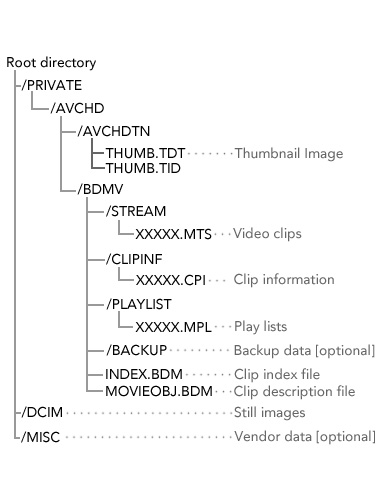Tip #1275: How an AVCHD Folder is Organized?
… for Codecs & Media
Tip #1275: How an AVCHD Folder is Organized
Larry Jordan – LarryJordan.com
The best way to handle AVCHD is to transcode it.


AVCHD (Advanced Video Coding High Definition) is a format for digital recording and playback of high-definition video developed jointly by Sony and Panasonic. An AVCHD file is actually not a single video file, but a hierarchical file structure derived from the file structure you would find on a Blu-ray disc, containing multiple video clips.
On OSX, the AVCHD folder is automatically viewed as a package (aka bundle). If you are not familiar with packages on OSX, a package is a file system folder that is normally displayed in the Finder as if it were a single file. A package can contain hundreds of other folders and files and such. An iPhoto Library is a package, for example. In addition, OSX further treats the BDMV folder as a package as well.
The problem is that macOS does not handle AVCHD files well, including limited QuickTime support, inability to rename the files in the AVCHD bundle, and extracting just the file you want to access.
Instead, it is better to simply copy the ENTIRE AVCHD folder to your hard disk, open it into your NLE and import just the clips you need for your edit.
Ideally, it would also be good to transcode that original AVCHD media (which uses the H.264 codec) into something easier to edit, such as ProRes 422.
Here’s an article from Vector15.com that describes AVCHD in more detail.


What I’ve found is that FCPX will automatically re-wrap the .mts files as .mov files, and put together multiple 4 GB clips into one seamless clip (for longer recordings). Then I can move those out of a FCPX Library. Yes, it destroys the library, but that’s not the point. Even though it is still more steps, at least it doesn’t leave me with a bunch of .mts files that are hard on the Mac ecosystem. By moving them in Finder, and then reimporting the .mov files to another FCPX Library, I have a much easier and containerized video file to work with, both inside of FCPX or outside of it when working with say another program such as Premiere Pro.
Joby:
Great tip. Thanks!
Larry
VERY relevant to owners of new Sony cameras like the A7Siii!!